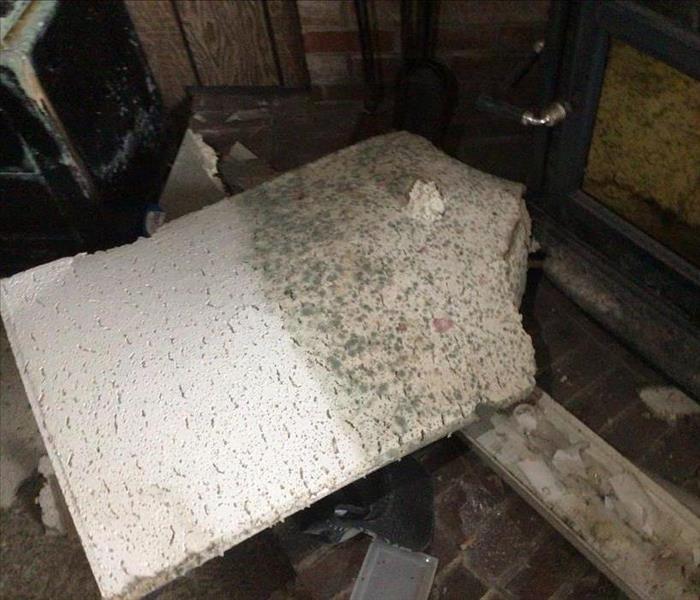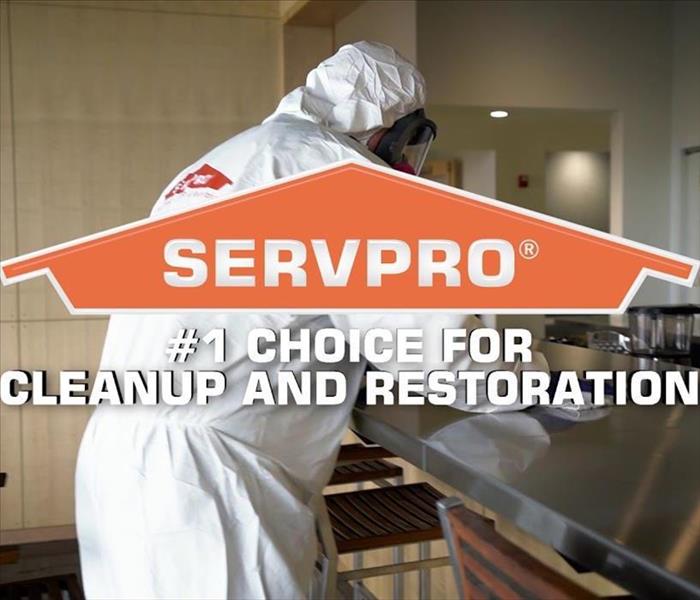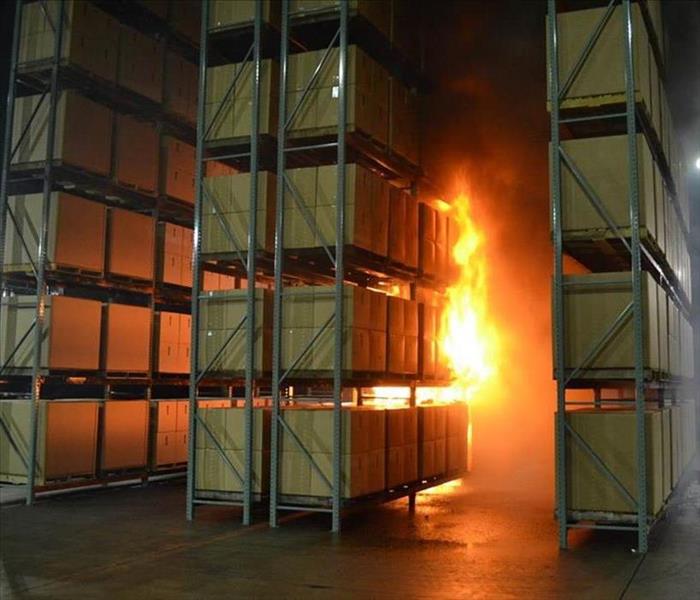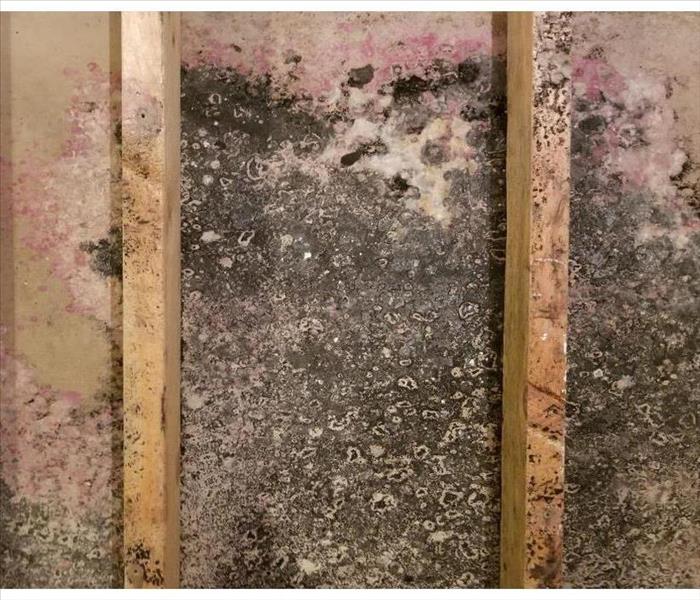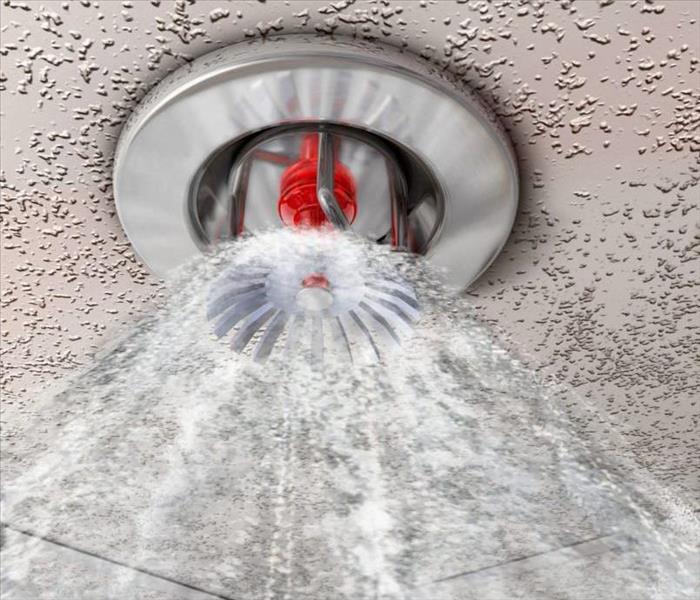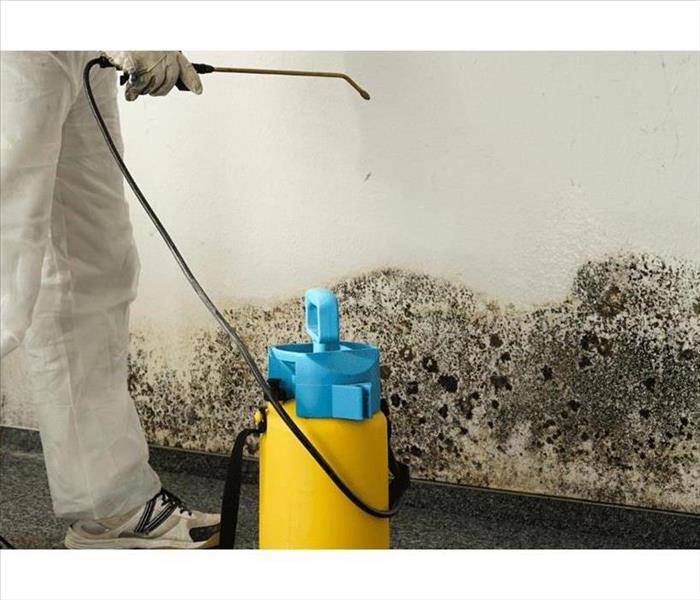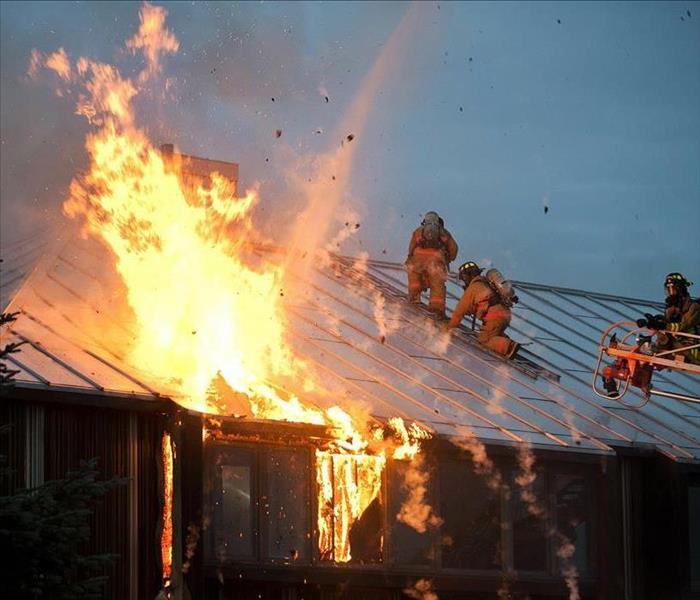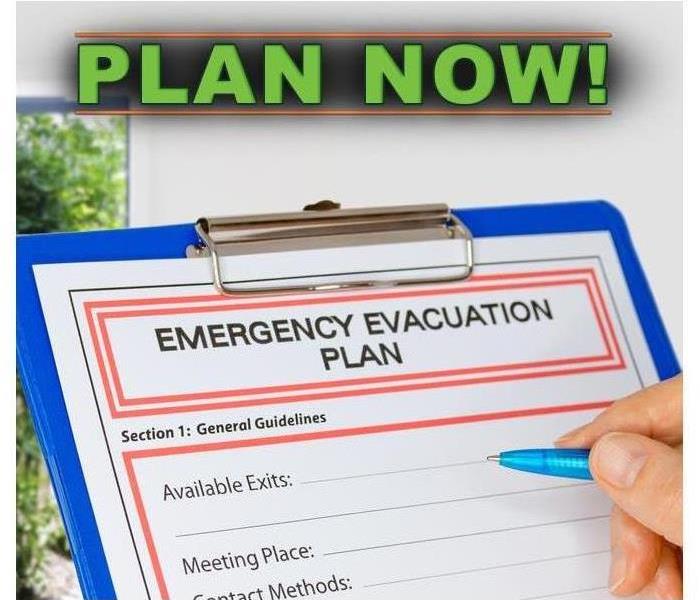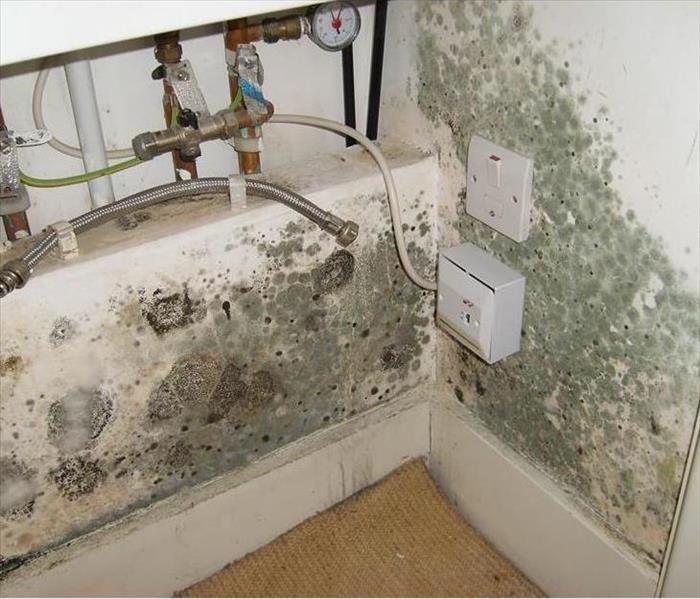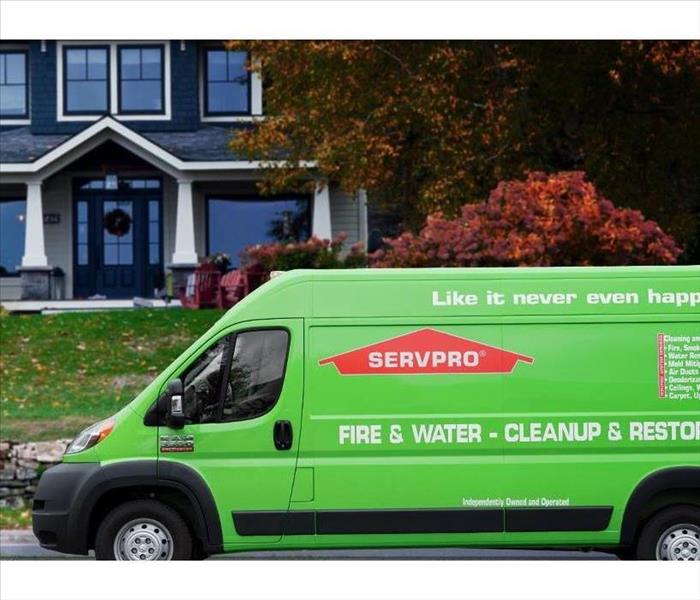Recent Commercial Posts
Get Rid of Persistent Mold Growth
8/1/2022 (Permalink)
Don’t let trouble mold spots get you down. Mold growth can continue to occur in the same areas, leaving your business looking outdated and affecting the air quality for your customers and employees. Discover how to conquer those trouble spots and restore your business.
How Does Mold Grow?
First, it’s important to determine what is causing your persistent mold to continue to grow. Here are a few common features that promote the growth of mold:
If all these signs point to mold, invest in a commercial mold remediation company who understands how to get rid of trouble spots and prevent further mold. A specialist can help you identify the type of mold and choose the correct route to completely remove the discolored areas.
Removing Mold
The first step in mold removal is to contain the mold growth. A small spot can quickly spread throughout your commercial building, particularly if it’s in or near your HVAC system. Proper air filtration and mold removal techniques allows you to enjoy a clean, professional look and feel to your commercial property.
Protecting Humid Areas
One of the most likely areas of persistent mold is an area containing high humidity. Humid environments are the most likely to spread mold, so discuss with a mold remediation company where your likely areas of humidity are and how to prevent them from continuing to harbor mold spores.
Contact a Professional Today
Discover how a mold removal specialist can remove persistent mold spots “Like it never even happened.” From large areas of water damage to a damp corner of a storage closet, no mold growth can hide from a thorough inspection and removal process by a trained team of specialists. Keep track of likely areas of persistent mold and be sure to choose a professional cleaner who is experienced in commercial remediation.
Regular Maintenance To Your Commercial Roof
7/18/2022 (Permalink)
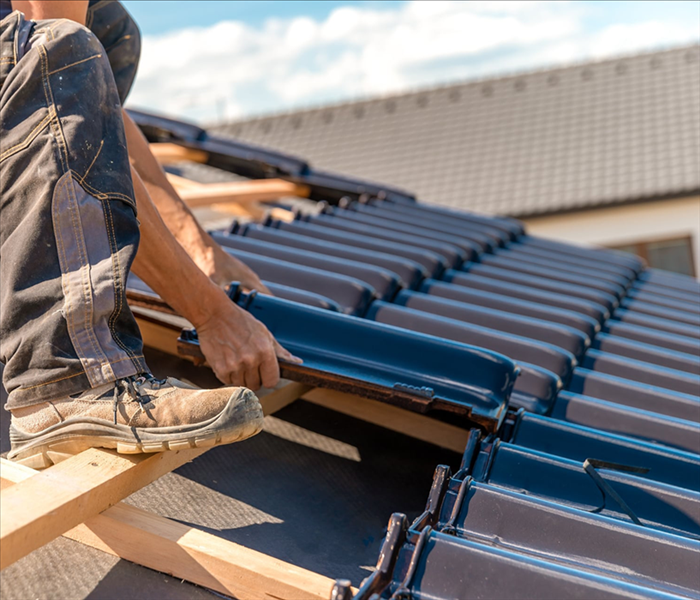
Your roof is probably the most important exterior element of your business. Every day, it defends your building against damage from weather elements including wind, rain, sleet, and extreme heat and cold. That’s why regular maintenance to prevent potentially catastrophic issues such as a roof leak is so important. By keeping a few basic upkeep guidelines in mind, you can extend the life of your commercial roof and ensure your business is shielded from natural threats.
1. Conduct a visual inspection. Many major roof problems can be identified by simply examining the condition of the roofing material. Any excessive standing water due to rain, snow, or melting ice can cause leaks that will rot wood and rust steel. A “bubbling” effect where roofing materials begin to separate from the base is a possible sign of trapped moisture that may also lead to major leaking. Gaps in the strips of metal around a roof’s perimeter can weaken its structural integrity and increase the potential for wind damage.
2. Schedule regular maintenance. Twice yearly upkeep in the fall and spring is essential in keeping your commercial roof in peak condition. Start by clearing the entire area of any debris including leaves, dirt, and gravel that can hold moisture and generate a roof leak. Clean all gutters and downspouts thoroughly to ensure proper damage during precipitation heavy weather events. Seal any gaps in rooftop vents that can allow water to enter and cause flooding.
3. Know when to contact a professional. While maintaining your own commercial roof can be very effective, extensive issues will require the services of a qualified roofing restoration professional. Major moisture damage, significant material loss due to heavy winds, and destruction due to a major weather event like hail are all problems that should be handled by a professional.
While maintaining your commercial roof will require an investment of time and money, it’s one of the most important steps you can take to prevent major issues such as a roof leak that will threaten your business.
4 Reasons to Have Your Business Professionally Cleaned After a Flood
5/26/2022 (Permalink)
If your business has recently experienced flooding due to a storm, pipe burst, or other cause you might feel overwhelmed trying to figure out what steps to take next.
The restoration process following a flood is often very extensive and may require the use of special equipment, especially if any mold growth has occurred. For this reason, you should always seek the aid of a flood and storm cleanup company. Here are important ways these professionals can help.
- Eliminate Foul Smells
After a flood, you might notice several different types of tainted odors in your building. Common odors include a musty or dirty stench caused by mold, the smell of sewage, or strong scents left behind by chemicals that have made their way into the flood water. A cleanup company can help by removing the source of the odor and using professional equipment to purify the air.
- Prevent Further Mold Growth
Improper cleanup after a flood can result in mold, which thrives on excess moisture. A professional crew can help remove mold that has already started to grow and prevent any spores from spreading.
- Protect Against Harmful Contaminants
Depending on the source of the flood water, your building might encounter harmful contaminants. If the flood came from somewhere outside of the building, such as an overflowing river, or resulted due to sewage loss, you need to call in the professions immediately.
- Preserve Important Items and Belongings
A flood can cause damage to important items such as important documents, expensive equipment, and personal belongings. By working with a flood cleanup company, you may be able to restore many of these items.
From pesky mold growth to foul odors, there are many ways flooding can affect your business. Make the cleanup process as easy as possible by getting in contact with a professional cleanup company right away.
3 Ways to Reduce Your Commercial Fire Risk
5/19/2022 (Permalink)
Most people have never had to operate a fire extinguisher or flee a burning building, yet according to the U.S. Fire Administration, each year over one million structure fires cause damage to property. If you want to reduce the risk of fire damage for your business, follow these 3 simple steps:
Fire Extinguishers
The benefit of well-placed fire extinguishers can’t be overstated. The following facts about commercial fires illustrate importance:
- A high percentage of commercial fires don’t require an emergency response because an extinguisher was available
- Most business fires happen when workers are present, and a small fire can be handled with a good fire extinguisher
- Cleaning up a little bit of foam from the extinguisher is far preferable to the damage that can occur while waiting for emergency responders to arrive
Knowing where to store your extinguishers and how to use them are crucial factors in their effectiveness. It is essential your employees know where your extinguishers are located and their proper operation. Your local fire remediation specialist or fire department can help evaluate your site and recommend the number and placement of fire extinguishers.
Smoke Alarms
Commercial building codes require smoke alarms because they are your best chance of detecting smoke and fire in the early stages. A working smoke alarm and a good fire extinguisher can be a life saving combination. Consider including smoke alarms on your facility maintenance schedule. Backup batteries should be replaced every six to nine months, and the alarm exterior should be vacuumed occasionally to remove dust and lint.
Fire Sprinklers
Most regional building codes require fire sprinklers in commercial buildings. They may save your facility if a fire starts when no one is in the building. If no one is there to hear the alarms, the sprinklers can completely extinguish a fire or keep it at bay until emergency services arrive.
A small kitchen fire in your lunchroom doesn’t have a chance against the fire prevention triad: a working smoke alarm system, nearby fire extinguishers, and fire sprinklers. They can be the difference between a little smoke damage and costly commercial property damage.
Five Areas That Mold Can Be Found in Your Building
5/3/2022 (Permalink)
If your commercial building has experienced widespread damage due to a flood, it can be near impossible for you to track down all the areas that have been saturated with water. If water damaged areas are not addressed in a timely manner, mold growth can take over your building. To keep the situation from growing out of control, it is essential you get help from an emergency restoration specialist to remove standing water and stop mold in its tracks. Here are five common areas that mold can be found in your building after a flood.
- Flooring Materials
While wet flooring is a common place where mold can be found, it is often hiding below the surface where you can’t see it. Often, soaked porous materials, such as carpeting and certain types of hardwood floors, need to be discarded.
- Appliances
Mold and other bacteria may start to develop in the refrigerator after a flood, especially if the power went out for an extended period. Growth can also occur in ovens, dishwashers, and washing machines if the insulation gets wet.
- HVAC Systems
Mold growth in your HVAC system is particularly problematic. Don’t turn on your system until all mold is removal to keep it from spreading to other areas of the building.
- Walls
Water can saturate drywall and plaster, making its way deep into your building’s structure. Removal of affected walls is typically necessary to find and remove any mold.
- Furniture and Other Personal Contents
Furniture, office equipment, and personal belongings left in the building at the time of a flood can be a suitable surface for mold to grow on. A content cleaning specialist can be helpful for restoring any salvageable items.
What may start out as a small amount of fungus can spread quickly, thriving in areas that contain standing water and excess humidity. A restoration specialist can target mold growth in these areas and get your building back to its pre-flood condition.
The Secret to Having a Reliable Fire Sprinkler System
6/30/2021 (Permalink)
Automatic fire sprinklers are an ingenious idea, designed to save lives and protect property. However, most businesses set and forget these systems, and that is where they go wrong. Neglected sprinklers are more likely to fail in the event of a fire, or cause water damage if they leak. Here are some of the things you could do to avoid sprinkler failure in your business.
Regular Sprinkler Maintenance
Sprinkler maintenance is the first step towards securing your property from a fire. For example, if you have a wet pipe system, there is a high chance water could freeze in the piping, resulting in a lot of pressure in that area. Such situations can break fittings or forcefully open sprinkler valves.
Other reasons for sprinkler failure include:
- Mechanical damage
- Corrosion
- Deliberate sabotage
You have two options when it comes to maintaining a sprinkler system – do it monthly or quarterly. Most companies in this line of work charge surprisingly low rates for this service, and it can save you thousands of dollars in return.
Use the Right Materials
Steel-based sprinkler systems are more likely to fail compared to CPVC systems. Metal gets corrosion and scaling over time, leaving it at a high risk of blocking. It happens when the metal’s ions break away after reacting with stationary water that has 6.5 PH or more. These particles build up in one spot, and that translates to more maintenance expenses.
Scaling is a result of water minerals settling to form a solid layer in the pipes. That limits water flow during a fire and can even clog the sprinklers completely. To avoid these complications, replace the entire system with a newer one that will not corrode or let the water freeze.
That said, it is essential to schedule regular sprinkler maintenance with a local company. It will not only save you from potential body injury claims, but it will also protect your business from a fire.
Can Employees Go to Work During Mold Removal
6/9/2021 (Permalink)
Building or business owners may want to continue operating during mold remediation. It can be possible to do so depending on the containment methods in use and how much of a structure will be affected by mold removal. Owners should consider the following factors to provide employees with a safe working environment during remediation.
Confirm the Containment Strategy
The extent and type of mold present in a structure will determine whether containment is necessary. These measures will affect the portion of a building affected by mold growth that is being removed:
- Limited containment for contamination of 10 to 100 square feet
- Full containment for contamination of over 100 square feet
- Airlocks and decontamination chambers for major infestations and toxigenic species, such as black mold
If employees usually work in an area that is now contained, it will be off-limits during mold removal. These individuals should be relocated until remediation is complete.
Relocate Within a Structure or to a Temporary Location
Even if a work area is not within a containment zone, it can still be helpful to relocate staff to another part of a structure or a temporary location. As long as work can continue, a business owner should not need to make an interruption insurance claim.
Turn Off the HVAC
Air conditioning, heating, and fans can spread spores throughout a structure. Even if limited or full containment is in use with negative air pressure, an HVAC system may still spread preexisting spores throughout a structure. Climate control and ventilation should not be used until the main unit and ductwork have been cleaned.
Be sure to inform employees about the remediation process. Notifications about the mold removal schedule and safety measures can help to maintain productivity levels during this time. Building and business owners can trust that removal will be completed thoroughly and quickly by certified mold remediation professionals.
What to Do if Your Roof Has Been Damaged in a Fire
5/18/2021 (Permalink)
Sometimes a fire can be contained quickly, and the effects can be minimized. Other times, it can result in severe damage to your building. This can include broken windows as well as missing walls and roofing. When this happens, it is important to have fire cleanup and repairs done as quickly as possible to reduce potential secondary damage. If your roof has been damaged, the following steps should be taken.
Mitigate the Damage
The first thing that you should do is mitigate to prevent the damage from worsening. If parts of your roof are missing, you can contact a professional to have tarp services done. This will help keep debris from falling into the building through any holes in the roof. It will also prevent water damage in the event of a storm. In severe cases, using thin wooden boards in place of the tarp might be a better option.
Clean and Sanitize the Area
Before repairs on the roof can begin, fire cleanup will need to be done in the area. Because smoke and soot can create long-lasting odors, this should be entirely removed from affected roofing along with any debris. If the fire department puts the flames out with a hose, there may be some moisture trapped here as well. Make sure that the area is thoroughly dried and cleaned to prevent the growth of mold.
Make Repairs
Once the fire cleanup has been completed, repair work can begin. Any boards or shingles that have been damaged should be removed and replaced. The repairs process will include work on the appearance of the roof as well as its structure so that you will likely not be able to tell that a fire has taken place at all.
Roof repair after a fire is an important step in returning your building to its previous condition. To get the best results, call a professional cleanup and restoration service to do the work for you.
The Emergency Action Plan: Understanding the Basic Principles
5/14/2021 (Permalink)
How ready is your business for an emergency? Everyone should have a contingency plan in place because you never know when you will need it. You need to know that your employees are safe and accounted for in the event of a disaster. Therefore, you should understand the basics of an emergency action plan.
Make a List of Contacts
Every well-crafted evacuation plan requires a list of contacts. By ensuring contacts are regularly updated, you can keep track of people in a more thorough way. For instance, if your business is evacuated because of a fire, you can double-check counts to your list of contacts, and you can reach out to anyone not accounted for.
Designate and Assign Clear Evacuation Routes
An emergency contingency plan should include several exit routes designed to lead outdoors from every point in the building. Additionally, employees should be assigned a route that corresponds to their section of the building. This allows evacuations to happen in an orderly and predictable manner.
Design a Way to Account for Employees
You may also want to assign specific floor managers to specific exit routes, making them responsible for counting and verifying everyone assigned to their route. This will make accounting for all personnel easier, and it will allow a small group of managers to interact and check numbers.
Know Who Is Responsible for Reporting Fires
You should assign the task of reporting fires to specific people yet encourage others to call as well. By assigning the responsibility, you ensure someone reports the problem, but by encouraging others, you make certain that no one drops the ball.
Beyond reporting fires to emergency services and your insurer, you should keep a disaster restoration specialist in the area on file. These professionals may even set up an emergency plan with you, making the process that much easier. A proper contingency plan in the event of an emergency can be the difference between life and death. Keep your employees and yourself safe by planning ahead and seek assistance when and if you need it. SERVPRO of West Hills & North Washington County offer free assessments of your business’s preparedness, so give us a call at 412-299-5520 to schedule!
Is Your Company Covered for a Mold Claim?
4/28/2021 (Permalink)
The right amount of general liability insurance for your company protects you from life's unexpected moments. One of these surprises could be the presence of mold in one or more corners of your property. What exactly, though, will your insurance cover for a mold outbreak? Mold insurance claims are often downright confusing, so it is always a good idea to have a detailed discussion with your agent at least once a year. Policies and coverage can change without warning, so it is best not to assume you have extended mold coverage for your business.
Beware of Exclusions
Mold exclusions in policies began showing up in the 1990s in response to some hefty awards handed out to policyholders. It is called a "fungus exclusion" and puts limits on the following mold insurance claims:
- Loss or damage caused by mold
- Loss or damage caused by dry rot or bacteria
- Loss or damage caused by mold spores, toxins, smells, and by-products of fungi
Property owners can still collect on a mold claim through a few exceptions to the fungus exclusion. A term known as Limited Fungus Coverage applies to the cleanup and repair of damage caused by a mold outbreak. In short, reasonable expenses for mold remediation are allowed in these cases.
Watch Out for Policy Changes
In addition to speaking with your insurance agent, ask about the availability to pay higher premiums for more robust coverage. In all cases of mold growth, call in a mold mitigation team that will arrive and begin the remediation process. A mold outbreak moves quickly, spreading through the HVAC system and other pathways. A rapid and professional response cuts down on costs. You can limit your mold insurance claims with prompt action and keep expenses and damages below the $15,000 normally approved for damages. This limit for damages is an annual limit and includes expenses associated with mold mitigation.
We Can Handle Any Size Water Loss
4/23/2021 (Permalink)
What do you do if you have a massive water loss in your business? The best choice is to call SERVPRO of West Hills & North Washington County immediately to begin the water extraction process. Once on-site, a dedicated member of our team will start to scope the project and give you a time frame to get the job done.
It is so important that you make sure the water is removed from the building as quickly as possible. Failure to do so can result in other forms of microbial growth. This can cause a more expensive mitigation job as well. SERVPRO of West Hills & North Washington County has the team and equipment to make sure the job is done right from the very start.
Once all the water is removed, SERVPRO of West Hills & North Washington County will begin to place all drying equipment to get the job dried. Each day the job will be carefully monitored from start to finish. After the structure is dry, SERVPRO of West Hills & North Washington County will remove all equipment and help with any necessary repairs.
If you have any questions, do not hesitate to reach out to us at 412-299-5520. We are always here to help.
3 Ways To Prepare Your Business for a Winter Storm
6/26/2019 (Permalink)
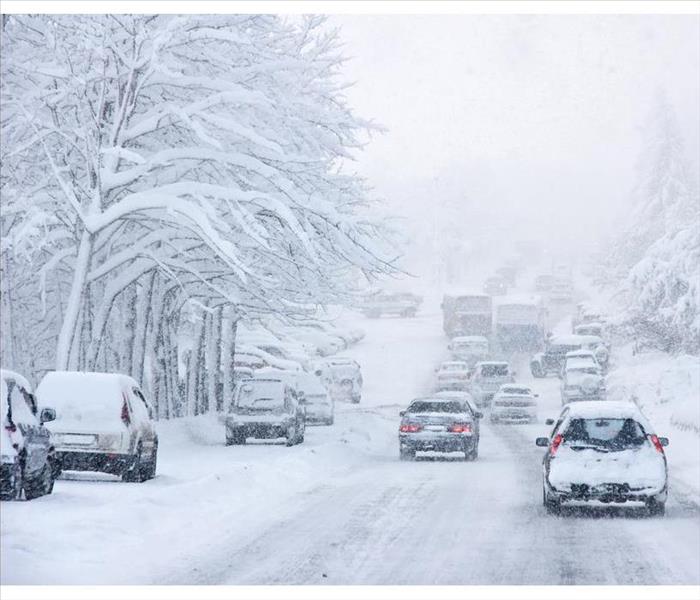 A winter storm has the potential to devastate a business
A winter storm has the potential to devastate a business
Prepare Your Business Prior to a Winter Storm
A winter storm in Fayetteville, PA, can wreak havoc on businesses, and many people are unsure how to prepare their businesses before a storm occurs. However, making preparations prior to a storm can ultimately save you time, money and stress.
1. Examine Your Building Prior to the Storm
Burst pipes, structural damage and water damage can often occur after a storm. Examining your property before a storm, however, can help to prevent such damage from occurring. If you examine your property prior to a storm, you are likely to notice any small issues, such as a pipe leak or cracks in the structure of your building, that could make storm damage more likely. If you notice any problems that could result in major damage, you have the chance to fix the issues before the storm hits.
2. Back Up Important Documents
A winter storm can often cause a power outage in your building, which can make it difficult to access important documents you may need. Before a storm, it can be useful to back up important documents by uploading documents to a cloud or a hard drive. Additionally, making physical copies of documents that you might need during and after a storm can be helpful in case you don't have access to the internet.
3. Be Prepared for Snow Removal
Storms can often result in businesses sustaining structural damage. Though removing debris from your building and inspecting your property prior to a storm can be useful, structural damage can still occur and snow removal is often still necessary. If you know a storm is likely to affect your area, it can be useful to look for disaster restoration services you can contact if you need assistance after storm damage has occurred.
A winter storm has the potential to devastate a business. However, knowing how to prepare for this type of storm can pay off by preventing your property from sustaining major damage.
What is the fastest way to dry a large commercial space after it gets wet?
4/29/2019 (Permalink)
If you have a large water loss, it is critical to hire a professional restoration company immediately like SERVPRO of West Hills. There team is faster to any loss, and can help with each step of the project. From the initial emergency services, to the final repairs, SERVPRO of West Hills is the one company you can trust.
Each day the men and women of SERVPRO of West Hills wake up with the intention to help you through a tough time for your business. We understand the stress and frustration with dealing with all types of water damage. Our goal is to mitigate the damages and get your business back to pre loss condition as soon as possible.
If you have questions, we encourage you to reach out to SERVPRO of West Hills at anytime. We pride ourselves in being an educational resource to help you from start to finish. No job is too big for our team and we have the resources and experience to make sure the job is done right. If you have any questions call us anytime, 24 hours a day.
Faster to Any Size Commercial Disaster
4/28/2019 (Permalink)
SERVPRO of West Hills is the fastest company to utilize in the West Hills area. Our team has the experience and manpower to handle any size job. From start to finish, you will love how professional SERVPRO of West Hills will be on your job site.
With any disaster, timing is extremely important. Our team from the moment they get the call, will rush to get on site and begin helping you. The longer damages sit, the more damage it can cause, especially when dealing with water. Each minute the water can be wicking and spreading.
SERVPRO of West Hills treats every small and large job as a priority. We know the frustration and pain that a water loss can cause. Our team carefully assesses each aspect of every job to make sure you get the proper treatment that you deserve. If you have any questions, we encourage you to reach out to us at anytime. We operate 24 hours a day, 365 days a year.
What is the best way to clean up after a commercial water loss?
4/23/2019 (Permalink)
SERVPRO of West Hills is the premier choice to call after a water loss. Our team of IICRC certified technicians can handle any large or small loss in the West Hills area. Our team has the equipment and manpower to get any size job done from start to finish, in a short amount of time. If you have questions, we encourage you to contact us at anytime.
It is important that on any large commercial loss you get the environment under control as soon as possible. SERVPRO of West Hills will typically begin emergency services right away to help remove all standing water. Once all of the water is removed, they will begin to place plenty of drying equipment throughout the facility.
Each day SERVPRO of West Hills will be on site to monitor the drying process. It is critical to make sure that the drying process is taking place and that it is being recorded in the job log. After a few days, and the job is dry, SERVPRO of West Hills will remove all of the equipment. From there they can complete any repairs that might be needed.
If you have any additional questions, do not hesitate to reach out at anytime. SERVPRO of West Hills is always here to help.
How to remove water from my business after flooding
4/23/2019 (Permalink)
How to remove water from my business after flooding
Have you ever experienced flooding in your business after heavy rains? If so you might know the challenge it takes to get things cleaned up and back to pre loss condition. SERVPRO of West Hills is the premier choice to help get your property back to pre loss condition. Once on site SERVPRO of West Hills will perform the initial Emergency Service work. This will include the initial extraction of all of the standing water.
After all of the water has been removed, SERVPRO will make sure that the right amount of green drying equipment is in place. You have probably seen our Green Fleet at SERVPRO of West Hills around town. Each day, SERVPRO of West Hills will monitor the progress of drying until the entire job is complete.
If you have any questions, we encourage you to call SERVPRO of West Hills at anytime day or night. Our team is always here to help. No matter what type of job, we can get the job done quickly and efficiently.





 24/7 Emergency Service
24/7 Emergency Service
